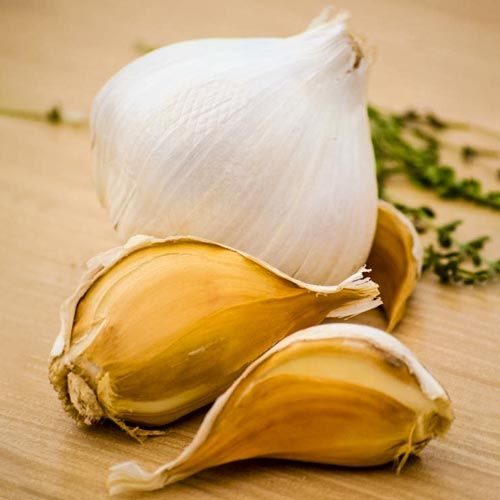Fresh garlic is a cook’s dream, whether grated into pasta, chopped for a sauté with vegetables and chicken, or blended into fresh salsa. Most people are used to grabbing garlic bulbs from the grocery store and don’t even realize how easy growing garlic is. Garlic has other uses, too. The “stinking rose” makes an excellent insect repellent in the garden and has been used in home remedies for hundreds of years.
Gurney’s offers several varieties of garlic – from our Gurney’s Choice California White Garlic, a proven producer, to our Walla Walla Early Garlic, perfect for braiding. Check out Gurney’s for our full selection of garlic bulbs and seeds. Below are some tips for how to grow garlic.
What Is A Clove of Garlic?
A clove of garlic is a section of the garlic head or bulb. Depending on the variety and the size, a garlic head may have 4 to 20 individual cloves. Each clove is wrapped in a paper-like skin.
How to peel garlic is easy. Cut off the end of the clove and peel off the papery skin. Cooks often chop or mince garlic cloves for recipes. Fresh garlic is used in all types of ways in the kitchen—from making garlic butter and salsas to seasoning pasta dishes, stir-fries and vegetables.
The garlic clove is also what is planted in the garden. One clove will develop into a head of garlic. Like flower bulbs, garlic cloves are usually planted in the fall and harvested the following summer. While garlic cloves can be planted in the spring, they usually will not develop as large of garlic heads as fall-planted cloves do. For the largest garlic heads, plant large cloves in the fall. Like fall-planted flower bulbs, garlic bulbs grow best in full sun and in well-drained soil.
A Brief History of Garlic
Originating in South and Central Asia, garlic has been used for seasoning food and medicinal purposes for thousands of years. This close relative of onions, leeks and shallots has wide-spread appeal in many countries. In ancient time, garlic was used to provide strength, as a laxative and as a diuretic. In folk medicine, garlic was used to treat insect bites, arthritis, parasites and other maladies.
Like other plants, garlic came to America with the early settlers and was used primarily in medicine. In the United States, using garlic as seasoning didn’t gain popularity until the mid-1950s. Because of its pungent odor—and, when eaten, its tendency to cause bad breath and body odor, many people avoided eating it. The rise of French cooking helped elevate the use of garlic in America.
Now, garlic is used to flavor many Asian dishes, Italian recipes, oils and butters, salad dressings, soups, salsas and other recipes. Immature garlic bulbs, or green garlic, is often used in stir-fry and soups. Garlic scapes add a mild garlic flavor to stir-fry and other recipes.
Today, gardeners can choose from hundreds of garlic cultivars with a range of flavors and spiciness. How to store garlic is easy. Garlic bulbs can be stored at room temperature for several months—and also be stored in vinegar. Garlic can be dried and ground into powder, too.
How to Plant Garlic
Garlic is easy to grow, as long as you give it plenty of sunlight and well-drained soil. Most varieties can be grown in zones 3-9. You can find your grow zone here.
Garlic can be planted in the garden or a raised bed garden. Some gardeners even grow garlic in sunny spots indoors. For the best garden performance, select a location that receives at least 6-8 hours of direct sunlight daily. When selecting a place to grow garlic, avoid planting garlic in a space that was recently used to grow garlic or onions.
To prepare the garlic planting bed, mix organic matter, such as aged manure or compost, into the soil before planting. Also mix in a slow-release plant food, such as Onions Alive!™ Fertilizer. Till the soil to create a loose bed of soil.
When to plant garlic is either in the fall or spring. Fall planting is recommended for garlic– especially if growers want bigger, more flavorful bulbs. Here’s how to plant garlic: break the garlic bulbs apart a few days before planting, and plant the cloves about one month before the ground freezes.
How Deep to Plant Garlic
The cloves should be planted flat side (root end) down, with the tips about 2 inches beneath the soil, and cloves set 6 to 8 inches apart. Your newly planted cloves should then be topped with mulch (about 6 inches). Straw or even dried grass clippings can be used.
How to Grow Garlic
During the winter your garlic will stop growing, then start again in the spring. For optimal growth, follow these simple tips for growing garlic.
Fertilizing
Garlic loves nitrogen, so make sure you are fertilizing accordingly. An all-natural, slow-release fertilizer, such as Gurney’s Onion Food, is recommended.
Weeding
Because garlic is not good at competing with weeds for water, leave your mulch in place throughout the growing season.
Watering
Garlic plants need about 1 inch of rainfall weekly from spring to summer. If rainfall is not adequate, water them. Once the leaves begin to yellow in the summer, stop watering the garlic. This allows your bulbs to get firm
Types of Garlic
Garlic bulbs are available in two major categories: hardneck and softneck garlic. The hardneck garlic varieties have a central stalk and perform best in northern climates. Some favorite hardneck garlic varieties are German Red, Duganski and Music Garlic. Softneck garlic varieties are preferred in southern climates and are used for braiding. Some favorite softneck garlic varieties are California White and Nootka Rose Garlic. Elephant Garlic is not actually garlic, but has a mild flavor very similar to garlic.
Garlic for planting is sold in bulbs, and the bulbs are divided into cloves. One garlic clove will produce one garlic bulb. Depending on the garlic variety, a garlic bulb may have 4-20 cloves. When determining how many garlic bulbs to buy, start by determining how many garlic bulbs you want to grow, and then how many cloves are in each bulb.
Pruning
In mid-June, your garlic will flower. The savory tops, called scapes, must be removed to encourage bulb growth. Gourmet cooks like to use the scapes in dips, pestos, and other recipes, as they have a very mild garlic flavor. They also can be used in cut-flower displays.
How to Harvest and Store Garlic
Harvesting garlic is easy. Here’s how to harvest garlic: watch for the tops to yellow and fall over. When to harvest garlic is before the tops are completely dry (this usually happens in late June to early July). Carefully dig up each bulb. Avoid attempting to pull the bulbs out by the stalk, as this can cause the stem to break from the bulb and encourage rot. Once your bulbs are harvested, take them to a dark place, out of the sun; tie 6 to 10 of your plants in bundles and hang them up in a dry, shaded, slightly drafty area. This allows your garlic to cure. Curing garlic takes about six weeks.
Once curing is complete, you can cut the roots off of your plants, trimming about 1 ½ inches above the garlic bulb and being careful not to remove the outer skin. Old net onion bags are perfect for storing garlic and a great way to recycle. If you’d like to get a little more decorative with your garlic, instead of cutting off the stems you can braid them together to make a garlic braid, then hang them up in a kitchen or storage room. As your bulbs continue to dry, the flavor will increase, making them perfect for use in soups, stews, pasta, and roasts.
Garlic Pests & Diseases
While garlic is a fairly trouble-free garden crop, it can be affected by pests and diseases. Below are some of the most common problems—and pest and soil-borne disease control tips.
- Onion maggots: The onion maggot larvae feeds on roots and can destroy the plant. Disease control measures include using sticky traps and row covers.
- Onion thrips: Onion thrips nymphs feed on leaves. Good garden practices, such as cleaning up garden debris in the fall, can help control them.
- White rot: Caused by a fungus, white rot causes leaves to yellow and dieback. Control measures include planting disease-free cloves and not planting in areas that have been infected by white rot.
Nutritional Value & Health Benefits
Garlic is nutrient-rich, contains antioxidants and may have many health benefits. People have used it for a variety of ailments, including high blood pressure, high cholesterol, hardening of the arteries and the common cold. However, many medicinal uses have not been scientifically tested.
Nutrition Facts
Serving Size: 1 cup or 136 grams
Calories per serving: 203
Total fat: .7 g 1%
Sodium: 23 mg 1%
Total Carbohydrate: 45 g 16%
Dietary Fiber: 2.9 g 10%
Sugar: 1.4 g
Protein: 8.7 g 17%
Calcium: 246 mg 19%
Iron: 2.3 mg 13%
Potassium: 545 mg 12%
Source: www.nutritionvalue.org
Many people are surprised at how easy it is to grow your own garlic. Because it doesn’t require lots of space and is a must-have in the kitchen, it’s a rewarding plant to grow—and you can choose from mild-flavored varieties to spicy-hot varieties. Shop Gurney’s garlic bulbs today!”

